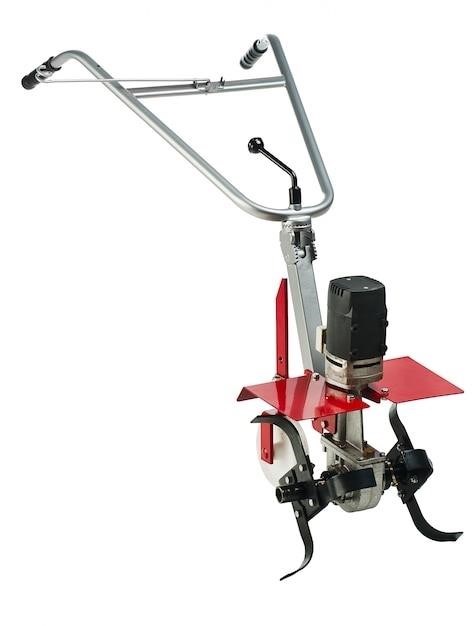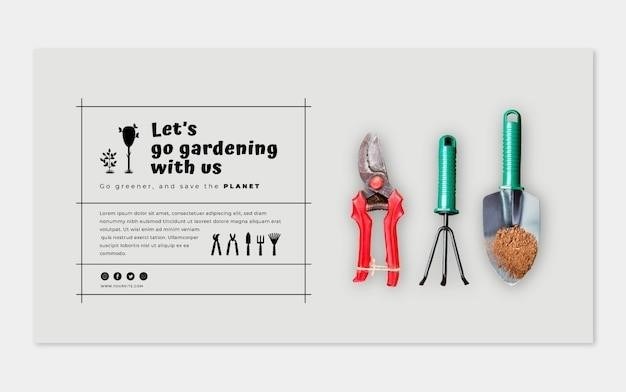mantis tiller operating instructions

This comprehensive guide provides you with the necessary information to operate your Mantis Tiller safely and effectively․ Discover instructions for assembly, fueling, starting, operation, maintenance, troubleshooting, and more․ Learn how to utilize your Mantis Tiller to its full potential and achieve successful gardening results․
Introduction
Welcome to the world of Mantis tillers, renowned for their lightweight design, powerful performance, and ease of use․ These compact tillers revolutionized gardening, making it accessible to everyone, regardless of strength or experience․ The Mantis Tiller’s unique serpentine tines effectively break up even the most compacted soil, creating ideal conditions for planting․ Whether you’re cultivating a small flower bed or preparing a large vegetable garden, the Mantis Tiller is your reliable companion․ This manual will guide you through every step of using your Mantis Tiller, from assembly to maintenance, ensuring a smooth and enjoyable gardening experience․
Safety Precautions
Operating a Mantis Tiller requires adherence to essential safety precautions to prevent accidents and injuries․ Always prioritize safety by carefully reading and understanding the instructions in this manual before using your tiller․ Wear sturdy footwear, gloves, and protective eyewear to safeguard yourself from flying debris and potential hazards․ Keep children and pets away from the operating area․ Before starting the tiller, ensure the area is clear of obstacles, loose objects, and any buried utilities․ Never operate the tiller on inclines or unstable surfaces․ Always maintain a firm grip on the handles and avoid operating the tiller when fatigued or under the influence of alcohol or drugs․ Be mindful of the rotating tines and keep hands and feet clear of the tiller’s moving parts․ If you encounter any problems or malfunctions, stop using the tiller immediately, consult the troubleshooting section of this manual, and seek professional assistance if necessary․ By following these safety guidelines, you can ensure a safe and enjoyable gardening experience with your Mantis Tiller․
Assembly
Assembling your Mantis Tiller is a straightforward process․ Begin by unpacking the tiller and locating the components, including the tiller unit, tines, handles, hardware, and the owner’s manual․ Carefully review the assembly instructions in the manual, paying close attention to the diagrams and steps․ Start by attaching the handles to the tiller unit using the provided bolts and nuts․ Ensure the handles are securely fastened and aligned properly․ Next, install the tines onto the axle shafts, ensuring they are properly seated and secured․ Refer to the illustrations in the manual for the correct tine orientation․ Proceed with attaching the carrying handle and any other optional accessories according to the instructions․ Once assembly is complete, double-check that all components are securely fastened and in good working order․ Before operating the tiller, familiarize yourself with the controls and safety features․ Remember to consult the owner’s manual for specific instructions regarding your particular Mantis Tiller model․
Fueling and Starting
Fueling and starting your Mantis Tiller is a crucial step in preparing for operation․ First, ensure you have the correct fuel mixture for your tiller model․ Mantis 2-cycle tillers require a 50⁚1 mixture of gasoline and 2-cycle oil․ Use a pre-mixed fuel container or carefully measure the oil and gasoline for a precise mixture․ Locate the fuel tank on the tiller and carefully pour the fuel mixture into the tank, avoiding spills․ Never overfill the tank․ Next, familiarize yourself with the starting procedure for your tiller․ Locate the choke lever, primer bulb, and starter cord․ Engage the choke lever, prime the engine by pressing the bulb several times, and gently pull the starter cord until the engine starts․ If the engine doesn’t start after a few attempts, check the fuel mixture, choke lever, and starter cord for proper operation․ Once the engine starts, disengage the choke lever and allow the engine to warm up for a few minutes before engaging the tiller tines․ Always refer to the owner’s manual for detailed instructions and safety precautions specific to your Mantis Tiller model․

Operation
Operating your Mantis Tiller is straightforward, yet requires attention to safety and proper technique; Begin by selecting the appropriate tilling depth for your needs․ Mantis tillers are designed for varying soil depths, ranging from surface cultivation to deeper tilling․ Adjust the tiller’s depth settings according to your garden’s requirements․ Ensure you have a firm grip on the tiller handles and maintain a balanced stance․ Start the tiller slowly, allowing the engine to reach its operating speed․ Gently guide the tiller forward, applying slight pressure to the handles․ The tiller’s serpentine tines will effectively break up the soil, creating a suitable bed for planting․ Remember to move the tiller in a consistent pattern, overlapping each pass to ensure uniform tilling․ Avoid sudden movements or abrupt changes in direction to prevent loss of control․ Always be mindful of your surroundings and avoid operating the tiller near obstacles or people․ Regularly inspect the tiller for any signs of damage or wear, and promptly address any issues to maintain optimal performance and safety․ Following these operational guidelines will help you achieve successful and efficient tilling with your Mantis Tiller․
Maintenance
Regular maintenance is crucial for ensuring your Mantis Tiller operates smoothly and lasts for years to come․ After each use, clean the tiller thoroughly, removing any dirt or debris that may have accumulated on the tines, engine, or housing․ Check the oil level and top it up if needed, using the recommended type and viscosity․ Inspect the air filter for dirt or blockage and clean or replace it as necessary․ Examine the spark plug for wear and tear and replace it if it appears damaged or eroded․ Tighten any loose bolts or nuts, particularly those attaching the tines and engine․ Lubricate moving parts, such as the tines and engine shaft, with a light oil to reduce friction and wear․ Store the tiller in a dry, sheltered area, preferably covered with a tarp to prevent dust and moisture damage․ Follow the manufacturer’s recommended maintenance schedule for specific tasks, such as replacing the fuel filter or checking the engine valve clearance; By adhering to these maintenance practices, you can ensure your Mantis Tiller remains in optimal condition, providing reliable performance for all your gardening needs․
Troubleshooting
While the Mantis Tiller is designed for reliable operation, occasional issues may arise․ If your tiller fails to start, first check the fuel level and ensure it’s properly mixed․ Inspect the spark plug for fouling or damage and clean or replace it if necessary․ Verify that the air filter is clean and not clogged, as this can restrict airflow․ If the engine runs but lacks power, inspect the air filter and ensure it’s not blocked․ Check the spark plug gap and adjust it if needed․ Examine the fuel lines for leaks or blockages, and ensure the fuel tank vent is clear․ If the tines fail to rotate, check the drive belt for wear, slippage, or breakage, and replace it if necessary․ Ensure the tines are securely attached to the axle and that the drive shaft is not jammed․ If the tiller vibrates excessively, check for loose bolts or nuts, particularly those attaching the engine and tines․ Inspect the tines for wear or damage and replace them if necessary․ If you encounter persistent issues, consult the owner’s manual for further troubleshooting steps or contact Mantis customer support for assistance․
Mantis Tiller Models
Mantis offers a diverse range of tiller models to suit various gardening needs and preferences․ Their popular models include the 7222/SV4, 7222/SV5C, 7222/SV5C/2, 7222/SV5H2, 7222E/SV5, 7222E/SV5C, 7225/SV5C, 7234, 7234/SV5CI, 7240, 7262, 7264, 7330, 7565, 7620, and 7621․ These models vary in features and specifications, such as engine type (2-cycle or 4-cycle), power output, weight, and tine design․ The 2-cycle models are known for their lightweight and maneuverability, while the 4-cycle models provide increased power and durability․ Mantis also offers electric tiller models, such as the Classic Electric Tiller and the Electric Cultivator 1000W, which are ideal for smaller gardens and eco-conscious gardeners․ Each model is designed to provide efficient and effective soil cultivation, making gardening tasks easier and more enjoyable․ To choose the right model for your needs, consider your garden size, soil type, and desired level of power and maneuverability․

Resources
For comprehensive support and information regarding your Mantis tiller, numerous resources are available; The official Mantis website, mantis․com, offers a wealth of information, including operating manuals, how-to videos, and maintenance tips․ You can also access these resources through their UK website, mantis․uk․com․ For specific model manuals, visit ManualsOnline, where you can find a wide range of user manuals for lawn and garden products, including Mantis tillers․ Additionally, Power Equipment Direct provides expert advice and deals on a wide range of power equipment, including Mantis tillers․ If you have questions about specific parts or need assistance with repairs, you can contact Mantis customer service at 1-800-269-2609, available 24 hours a day, seven days a week․ Mantis also offers a live chat feature on their website for quick and convenient communication․ For a visual demonstration of how to add fuel and start your Mantis Deluxe 4-Cycle Tiller, watch the video available on their website․ By utilizing these resources, you can ensure optimal performance and longevity for your Mantis tiller․